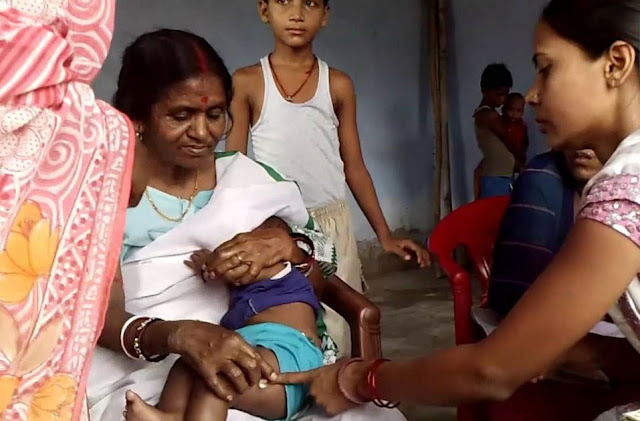ANTENATAL ADVICE
Antenatal means period from time of conception till the delivery.
Regular ANC Visit should be done. According to the WHO – at least 4 visit is recommended.
Regular ANC Visit should be done. According to the WHO – at least 4 visit is recommended.
- 16 weeks
- 24-28 weeks
- 32 weeks
- 36 weeks
 |
| USG In Pregnant Lady |
SYMPTOMS OF PREGNANCY
Sometime the women can’t make out that she is pregnant upto 3-4 moths of her pregnancy unless their tummy is seen. They may be unaware about the changes in their body. It is mostly common in women living in rural area. She should know what changes she will come across during her whole period of pregnancy. So here are some symptoms that the women experience during her pregnancy.
 |
| Pregnancy |
CERVICAL CARCINOMA SCREENING
Cancer of cervix is second most common after breast cancer.
Reduction in incidence depands on quality of screening program.
Risk Factors:-
- Age – 45 to 60 years
- First intercourse in young age
- Marriage or conception at young age
- Multiple sexual partner
- Smoking
- High – risk sexual partners
- Immunosuppresion – HIV
- Infections
- HPV (Genital wart – type 6 and 11; Oncogenic – type 16 and 18 most commonly)
- Herpes Simplex Virus - 2
SNAKE BITE MANAGEMENT
First Aid Snake Bite Treatment – RIGHT
- Reassure the patient. Control the anxiety. Lie flat with bitten limb below heart.
- Immobilise the limbby using splint. Don’t usetight compression band.
- Get to Hospital immediately.
- Tell doctor about the symptoms of the patient
 DO’S
DO’S- Allow the wound to bleed for 1-2min
- Clean the wound with disinfectant
- Put gauze pad over it and hold it with adhesive tape
- Remove tight clothes, shoe, watch and ring
- Immobilize the limb with splint
- Reassure the patient
- Transport to the hospital immediately
CARDIOPULMONARY RESUSCITATION
- Myocardial Infraction (MI) – most common
- Congenital Heart Disease
- Aortic Stenosis
- Dilated Cardiomyopathy
- Hypertrophic Cardiomyopathy
BREAST FEEDING
 |
| Breast Feeding |
Benefits
To Child:-
- Breast milk contains all the nutrients needed for the child growth and development. For eg:- carbohydrates, proteins, fats, vitamins and minerals.
- It has water content of 88% and child does not require any additional water during first few months.
- It contains number of immunological factor.
- The babies who are breast feed have better IQ than those who who were given other milk.
- It protect against illness like allergy, ear infection, etc.
To Mother:-
- Reduces chance of postpartum hemorrhage.
- It provide protection against pregnancy.
- It is the effective way of loosing extra weight that the mother has gained during pregnancy.
- It protect against certain cancer like breast and ovarian cancer.
- Any position comfortable to her and baby.
- She can sit and lie down.
- Her back should be supported and she should not be leaning on her baby.
Position of Baby
- Baby’s whole body is supported with the mother’s hand.
- Baby’s head and body are in one line with no twist in the neck.
- Baby’s body turned towards the mother (abdomens of the baby and the mother touching each other).
- Baby’s nose is at the level of the nipple.
- The baby’s mouth is wide open.
- Most of the nipple and areola in the mouth, only upper areola visible.
- The baby’s chin touches the breast.
- The baby’s lower lip is everted.
If mother is not in the position to feed her baby (eg, ill mother, preterm baby, working mother, etc), she should express her milk in a clean container and this milk should be fed to the baby. It should be stored at room temperature for 6-8hr and in refrigerator for 24hr.
Method
- Massage the breasts gently toward the nipples.
- Place the thumb and index finger opposite each other just outside the dark circle around the nipple.
- Press back toward the chest, then gently squeeze to release milk.
- Repeat step 3 in different positions around the areola.
Ten Steps To Successful Breast Feeding
Every facility providing maternity services (Nepal - Prasuti Griha Government Maternity Hospital, Thapathali, Kathmandu) and care for newborn infants should accomplish the following:
- Have a written breast-feeding policy that is routinely communicated to all health care staff.
- Train all health care staff in the skills necessary to implement this policy.
- Inform all pregnant women about the benefits and management of breast-feeding.
- Help mothers initiate breast-feeding within a half hour of birth.
- Show mothers how to breast-feed and how to maintain lactation even if they should be separated from their infants.
- Give newborn infants no food or drink other than breast milk unless medically indicated.
- Practice rooming-in (allow mothers and infants to remain together) 24 hr a day.
- Encourage breast-feeding on demand.
- Give no artificial teats or pacifiers (also called dummies or soothers) to breast-feeding infants.
- Foster the establishment of breast-feeding support groups and refer mothers to them on discharge from the hospital or clinic.
MEASUREMENT OF BLOOD PRESSURE
I am sure that you have seen the person who is suffering from hypertension in your life. It is so common that you will find the cases in your community also.
 |
| Blood Pressure Measurement |
Risk Factors (Non-Modifiable):-
1. Increasing Age
2. Family History
3. Ethnicity - black
It is mostly asymptomatic so routine checkup is necessary. But may present with "hypertensive headache" occurs in the morning and is localized to the occipital region. Other nonspecific symptoms include dizziness, palpitations and easy fatigability.
So it will be easy if you know how to measure the blood pressure by using sphygmomanometer at your home.
Subscribe to:
Posts (Atom)





